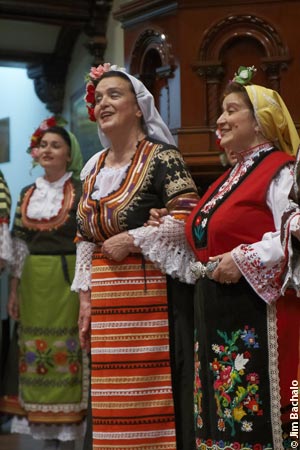| The room was teeming with an all-ages audience, peppered with illustrious representatives of several foreign embassies, smartly dressed tweens with a taste for musical complexity, as well as the odd sullen pre-teen, dragged out to experience some heritage from the old country. I caught sight of one such youngster playing a video game during a moment when the ethnomusicologist a few seats away and I were having fits of ecstatic delirium from the polyphonic chanting. For crying out loud, kiddo, this ain’t no virtual-world fake. From a starting point of two or three notes on a piano, these ladies (and two gentlemen) produced staggeringly complex sounds, whether in odd-times or no time at all, in piercing unison or up to seven- or eight-part harmony.
And beautiful. Several tunes featured a solo female voice out front, but the relationship between soloist and choir was not always as straightforward as that of foreground to background. On a few occasions, the choir would drop away, leaving two or three voices suddenly alone and droning. The choir would then play the role of the soloist, weaving in and out of tonalities before rejoining the few voices in a way that restored those few to their original harmonic role. Quarter-tone inflexions came to the fore in the small ensemble pieces, in which a duo, trio or quartet would take the stage alone. Most impressive were those moments when the whole group managed to slide in immeasurably small increments away from the centre of the pitch, further and further while bending but not subdividing the tempo, only to re-emerge back in key exactly one octave higher than the starting pitch. The effect was vertiginous.
What’s hilarious is the casualness with which they did it. Grinning and bouncing along (top-speed and eleven half-beats? Why not? It’s a folkdance, after all!), they were clearly enjoying the humorous stories the lyrics tell. Moving with ease from an atonal chatter representing the random sounds of a town’s worth of gossip, into incomprehensible harmony at the flick of the conductor’s index finger, they didn’t seem to be working hard in the least. Stacked clusters of tones were commonplace that night. So commonplace, in fact, one was tempted to think that it wasn’t a case of virtuosity but of simple and profound difference between the Eastern European aesthetic from which this music springs, and our predominantly Western European listening habits. Could it be that major harmonies are as staggering to them as the diminished and polyphonic harmony is to us? Alas, that comforting lie was debunked as soon as conceived, as, suddenly, a jarringly though perfectly executed barbershop-quartet-like segment invaded from out of Nowhere, only to disappear as mysteriously as it had come.
|
|
|



